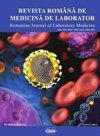抗中性粒细胞细胞质抗体相关性小血管炎肾损害患者血清可溶性Klotho蛋白表达及对预后的影响
IF 0.5
4区 医学
Q4 MEDICINE, RESEARCH & EXPERIMENTAL
引用次数: 0
摘要
背景:抗中性粒细胞胞浆抗体相关性小血管炎(AASV)是一种发病机制不明确的自身免疫性疾病,可导致多脏器系统损害、肾功能衰竭甚至死亡。我们旨在探讨血清可溶性Klotho蛋白在aasv肾损害患者中的表达及其对预后的影响。方法:将2012年6月~ 2014年6月收治的330例AASV患者分为肾损害组和非肾损害组。比较临床症状和实验室检查结果。将小鼠分为Klotho <935.05 pg/mL组和≥935.05 pg/mL组,比较肾脏损害及病理指标。采用Kaplan-Meier法绘制生存曲线,比较5年生存率和肾脏生存率。结果:与非肾损害组比较,肾损害组患者平均动脉压、尿蛋白、血肌酐水平显著升高,红细胞计数、血红蛋白、血清白蛋白、Klotho蛋白水平下降(P<0.05)。Klotho蛋白评价肾损害的最佳临界值为935.05 pg/mL。与Klotho≥935.05 pg/mL组相比,Klotho <935.05 pg/mL组血肌酐、尿蛋白水平显著升高,正常肾小球比例降低,纤维月牙比例升高(P<0.05)。Klotho <935.05 pg/mL组5年肾生存率显著低于Klotho≥935.05 pg/mL组(P<0.05)。结论:Klotho蛋白在AASV肾损害患者中低表达,可作为早期诊断和预后评估的潜在标志物。本文章由计算机程序翻译,如有差异,请以英文原文为准。
Expression of serum soluble Klotho protein in patients with renal damage induced by anti-neutrophil cytoplasmic antibody-associated small-vessel vasculitis and influence on prognosis
Abstract Background: Anti-neutrophil cytoplasmic antibody-associated small-vessel vasculitis (AASV) is an autoimmune disease with unclear pathogenesis, which causes damage to multiple organs and systems, renal failure or even death. We aimed to explore the expression of serum soluble Klotho protein in patients with AASV-induced renal damage and influence on prognosis. Methods: A total of 330 AASV patients treated from June 2012 to June 2014 were divided into renal damage and non-renal damage groups. Clinical symptoms and laboratory examination results were compared. They were divided into Klotho <935.05 pg/mL and ≥935.05 pg/mL groups, and renal damage and pathological indices were compared. Survival curves were plotted using Kaplan-Meier method, and 5-year and renal survival rates were compared. Results: Compared with the non-renal damage group, the mean arterial pressure, urine protein and blood creatinine levels significantly rose, while the red blood cell count, hemoglobin, serum albumin, and Klotho protein levels declined in the renal damage group (P<0.05). The optimal cut-off value of Klotho protein in assessing renal damage was 935.05 pg/mL. Compared with Klotho ≥935.05 pg/mL group, the levels of blood creatinine and urine protein significantly increased, and the proportion of normal glomeruli decreased, while that of fibrous crescents rose in Klotho <935.05 pg/mL group (P<0.05). The 5-year renal survival rate was significantly lower in Klotho <935.05 pg/mL group than that in Klotho ≥935.05 pg/mL group (P<0.05). Conclusions: Klotho protein is lowly expressed in patients with renal damage induced by AASV as a potential marker for early diagnosis and prognostic evaluation.
求助全文
通过发布文献求助,成功后即可免费获取论文全文。
去求助
来源期刊

Revista Romana De Medicina De Laborator
MEDICINE, RESEARCH & EXPERIMENTAL-
CiteScore
0.31
自引率
20.00%
发文量
43
审稿时长
>12 weeks
期刊介绍:
The aim of the journal is to publish new information that would lead to a better understanding of biological mechanisms of production of human diseases, their prevention and diagnosis as early as possible and to monitor therapy and the development of the health of patients
 求助内容:
求助内容: 应助结果提醒方式:
应助结果提醒方式:


